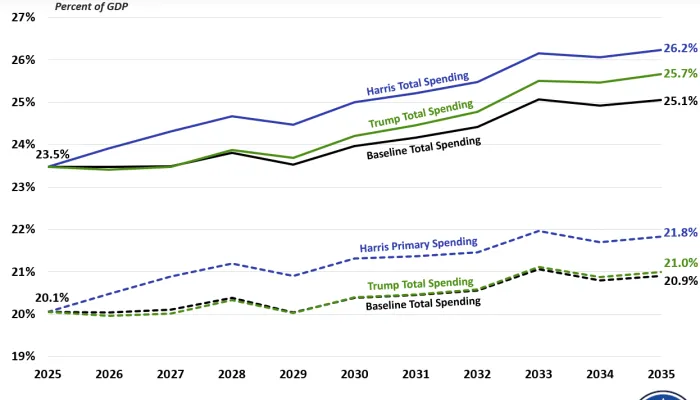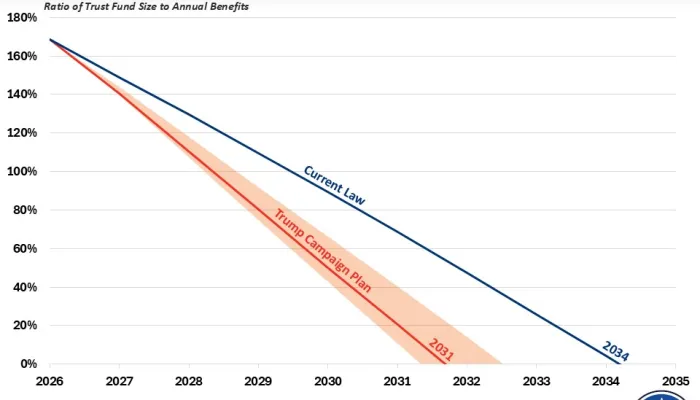Vivek Ramaswamy's Proposal to Increase Defense Spending
Vivek Ramaswamy, businessman and current GOP presidential candidate, has proposed increasing spending on national defense to at least 4 percent of Gross Domestic Product (GDP) per year through Fiscal Year (FY) 2032. Assuming this increase begins in FY 2026 – the first fiscal year for which the next President will submit a budget proposal – we estimate Mr. Ramaswamy’s proposal would cost approximately $4.3 trillion over a decade.
| US Budget Watch 2024 is a project of the nonpartisan Committee for a Responsible Federal Budget designed to educate the public on the fiscal impact of presidential candidates’ proposals and platforms. Through the election, we will issue policy explainers, fact checks, budget scores, and other analyses. We do not support or oppose any candidate for public office. |
On his campaign website, in a section dedicated to his “Independence from China” plan, Ramaswamy argues that “the U.S. should evolve from Ronald Reagan’s dictum of ‘peace through strength’ to Vivek Ramaswamy’s dictum of ‘prosperity through peace’ – by fortifying our badly-outdated U.S. industrial base through on-shoring production, partnering with democratic allies, and establishing a new floor of 4 percent of GDP on military expenditures through 2032.”
For context, defense spending has averaged 4.9 percent of GDP over the past 60 years and 4.1 percent of GDP over the past 40 years but has been well below 4 percent of GDP since FY 2013. Over the past decade, defense spending has averaged about 3.3 percent of GDP, including roughly 3 percent of GDP in FY 2022.
Based on the Congressional Budget Office’s (CBO) latest baseline, we project that defense spending will continue to decline as a percentage of the economy, to 2.9 percent by FY 2026 and 2.7 percent by FY 2032. Ramaswamy’s plan would thus increase defense spending by 1.3 percentage points of GDP per year by FY 2032.
For our estimates, we assume Ramaswamy implements his plan by sufficiently increasing appropriated defense budget authority, beginning in FY 2026, so that defense outlays reach 4 percent of GDP. Because budget authority takes time to spend out, actual defense outlays would not reach 4 percent of GDP until FY 2028. We also assume that beyond FY 2032, defense spending will grow with inflation and thus fall slightly as a share of GDP. Finally, we assume Ramaswamy’s definition of defense spending matches CBO’s ‘defense discretionary’ category of spending.

Based on these assumptions, Ramaswamy’s plan would increase defense spending by $4.3 trillion through FY 2035, including $2.7 trillion from the effects of increasing defense spending through FY 2032. In FY 2032 alone, his plan would increase defense spending by approximately $500 billion.
Under a stricter interpretation where defense discretionary outlays are boosted to 4 percent of GDP in every year between FY 2026 and FY 2032 and then grow with GDP instead of inflation through FY 2035, the cost would rise to about $4.5 trillion. Under a looser interpretation where mandatory spending on military health care and retirement benefits counts toward the 4 percent of GDP target, the cost would fall to $3.6 trillion. In either case, the costs would be significant.
*****
Throughout the 2024 presidential election cycle, US Budget Watch 2024 will bring information and accountability to the campaign by analyzing candidates’ proposals, fact-checking their claims, and scoring the fiscal cost of their agendas.
By injecting an impartial, fact-based approach into the national conversation, US Budget Watch 2024 will help voters better understand the nuances of the candidates’ policy proposals and what they would mean for the country’s economic and fiscal future.
You can find more US Budget Watch 2024 content here.


